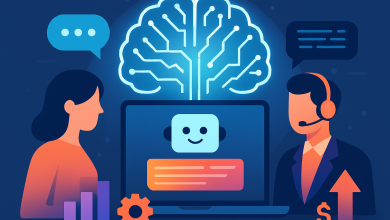
AI continues to promise to revolutionize the day-to-day of industries, governments, and consumers, but its applications could soon come to a screeching halt. The reality is our networks don’t all have sufficient infrastructure in place to satisfy AI’s demands. Not yet at least.
Fortunately, this opens the door to a major opportunity for telco operators. If they modernize their approach to building networks, they can not only own the market share of AI infrastructure, but also significantly improve the usefulness of AI in their own operations.
How? Let’s dive into the two major requirements for AI to reach its full potential, the factors holding us back, and the emerging trend happening in telecommunications that will enable this and more.
1. Modern AI infrastructure
For the past decade, data consumption has increased exponentially, and hyperscalers have been eating a large slice of the pie. Now, with the explosion of AI, there is massive market growth potential, and telcos are vying for a share. Those who can act fast may be able to get a leg up in the marketplace because the greater demand for AI, the more we will need the high-powered connectivity and computing infrastructure that large telcos can provide. In fact, McKinsey predicts that data center requirements could more than triple by 2030.
However, AI’s computing power also hinges on sufficient capacity at the edge of networks where they meet devices and individuals, and currently, our networks don’t have enough to meet rising demand. This means no matter if we have sufficient capacity within and between data centers, AI’s potential could soon be halted at the edge of our networks with no way to reach end users.
2. Rich set of real-time network data for operators
Additionally, for operators to benefit from their own AI-enhanced operations, its effectiveness will depend on its input data. While traditional telco infrastructure suffices when it comes to data extraction, it does not provide the largest or fastest source. For telcos to get the most value from their own AI tools and systems, they should be putting in as much information as possible. Otherwise, they risk walking away with only a fraction of what AI promises to achieve.
Network disaggregation to the rescue
Fortunately, a major shift is happening in telecoms that will solve both problems. Disaggregation, or the separation of hardware and software, gives operators more control over their network components. As a result, they can pair high-performance software with budget-friendly open hardware to build more efficient, scalable, cost-effective networks. Not only does this approach make them more competitive, but it also enables them to boost capacity at the edge to support AI.
On top of this, modern disaggregated network operating systems can also supply telcos’ AI tools with more data and visibility than ever before, while simplifying the extraction process and speeding up response times. The outcome is smarter, more valuable AI systems to help improve operations.
Significance for telecoms and other industries
With the support of network disaggregation, the potential for AI is massive. With enough capacity at the network edge, AI can become the powerful real-time sidekick it’s intended to be for both organizations and individuals. Its analytical capabilities could help identify future pandemics and predict earthquakes, or simply streamline customer support for companies. The possibilities would be endless.
For telcos themselves, AI promises to support in three main operational areas:
- Network planning: The mass amount of historical data that planning teams are required to sift through can be overwhelming. AI can help uncover trends and patterns such as subtle usage shifts, repeated faults, or capacity constraints that manual monitoring might miss. As a result, operators are better equipped to predict growth and make long-term decisions to meet demands, including upgrading infrastructure and improving resource allocation.
- Network optimization: Networks can involve millions of customers, thousands of nodes, and hundreds of pieces of equipment. With all these components, telcos struggle to cost efficiently optimize their networks on their own. Through interpreting real-time data and predicting subscriber behavior, AI can help balance traffic and subscribers on their infrastructure in a way that still delivers high-quality service.
- Fault resolution: Instead of relying on reactive troubleshooting, AI can quickly detect any issue the moment it occurs (or even predict it before it happens), identify its root cause, and realign network behavior in response. By automating fault analyses and resolutions, AI minimizes the required resources to conduct these processes and reduces the opportunity for misconfigurations or human error.
The longer telco operators rely on traditional, monolithic network architectures, the longer it will take to reach a truly AI-enabled world. If we hope to capitalize on the technology’s potential, network disaggregation must play a larger role in today’s networks. Otherwise, AI will continue evolving, but it won’t have an outlet – and we’ll all be left with empty promises.





